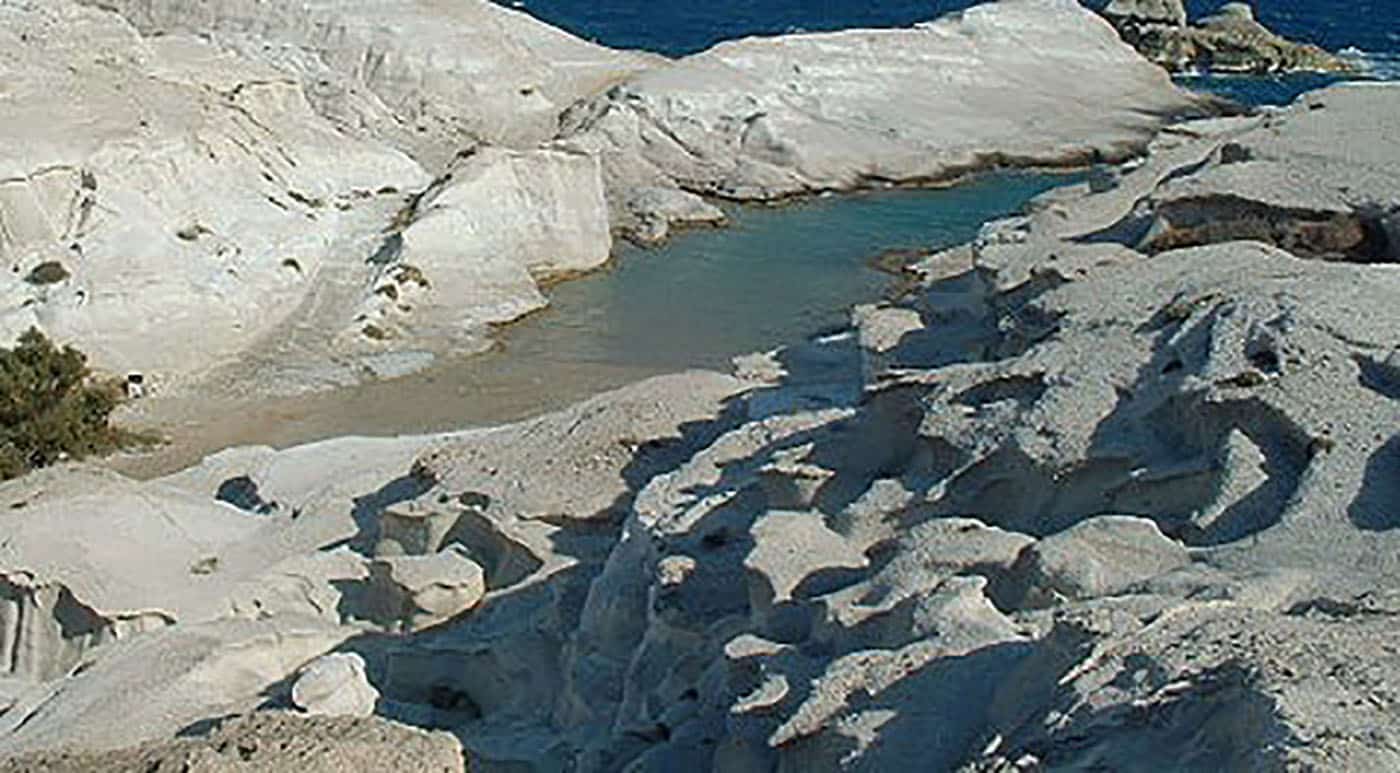Pigments that cure
The earth pigments of Melos
The technical and medical texts of the Greco-Roman world make it quite clear that earth pigments were used not only as colouring agents but also for their purported therapeutic properties. Our team has been investigating these pigments to a. identify their geological setting within the geographical locations of their origin; b. characterise their composition; c. explore their ecology by studying the microbial communities associated with them; d. evaluate their bioactivity as antibacterials against known pathogens. Our research focuses on Melian pigments, the white earth of Melos and other (yellow, red, green and black) pigments (see image below).
The white earth of Melos
Melian Earth was a white pigment from Melos, one of four main pigments used by ancient artists (black, white, red and yellow). It was compared to Eretrian Earth (from a town in the central Euboea) for its ash colour, but only the white variety was suitable for painting. It was commonly extracted from Melos’s white volcanic rocks.
Mentioned by Theophrastus, Pliny, and Vitruvius, it was renowned as a high-quality pigment. SE Melos is rich in kaolin deposits, with ancient quarrying sites possibly linked to its extraction. White rocks and artifacts from early mining operations suggest its historical importance.
It was predominantly composed of kaolin (a soft white clay) with impurities like quartz, cristobalite, and alunite. Kaolin’s properties provided high covering power, intense whiteness, and good mixing capability. It formed through volcanic processes, involving hydrothermal alteration that leached iron and left behind white minerals.
Early mining likely involved soft rock extraction using basic tools like stone or obsidian. Evidence of ancient mining includes archaeological remains near kaolin quarries. Kaolin was easier to mine due to its softness, contributing to its accessibility and use. Quality variability and the presence of impurities made Melian earth less competitive. Purer alternatives or more cost-effective pigments likely displaced it from the market by the 16th century.

The coloured earth pigments of Melos
Our work focused on collecting earthy pigments on Melos that could have been used by an artist, in antiquity or today, and in frescoes. They included reds, yellows, greens and blacks. Julie Gibney-Vamvakari, a Melian artist proceeded to use them in fresco decoration, while Iosifina Gounaki, a Cretan microbiologist, tested them for their bioactivity, as antibacterials (see publication below).
Our findings showed that a. some but not all pigments examined exhibited antibacterial activity; b. the method of their application matters, namely whether they were used as powders or as leachates; c. their natural microbial load may have played a role in shaping their bioactivity. Bioactivity is not simply a function of colour, local geology or composition but also of local ecology. Amongst the collection of earth pigments tested the black pigment (VANI-002) consisting of Mn-oxides was the most antibacterial, followed by the yellow pigment (RTK-001) consisting of alunite and jarosite (an iron potassium sulphate) and the green (TXS-002) consisting of melanterite (a hydrated ferrous sulphate).

Kean Miltos
Miltos from Kea was the highly prized, naturally fine, red iron oxide-based mineral of antiquity used as a pigment, in boat maintenance, in agriculture and in pharmacological preparations. The frequent reference of miltos in association with boats suggested not mere decoration. We found that some samples of Kean miltos were high in Pb. It follows that, if such samples of miltos, placed in an organic medium like pitch, were to be applied to a wooden surface like a ship’s hull, they would not have allowed the growth of a biofilm (on which barnacles attach themselves); as such they would have indeed acted as an efficient antifouling agent.
Red Lemnian earth was frequently referred to in antiquity as Lemnian miltos; indeed, the similarity in colour is striking (see photo below); but compositionally they are quite distinct. Also the method of their use, as leachates (Lemnian Earth) vs powders (miltos) was quite different, underpinning their bioactivity.
We suggest that bioactivity of miltos, its effect on living organisms (biofilms, plants or humans) was the result of a interactions between mineral and its natural microbiome; it is the combined effect of the biotic and abiotic components that gave miltos, its bioactivity.
The G-R world understood natural materials as an integral part of their ecological setting. They worked at enhancing their properties and tailored them to an intended specific application.

References
Knapp, C.W., Christidis, G.E., Venieri, D., Gounaki, I., Gibney-Vamvakari, J., Stillings, N., and Photos-Jones, E. (2021) The ecology and bioactivity of some Greco-Roman medicinal minerals: the case of Melos earth pigments. Archaeological and Anthropological Sciences, 13(10), 166. (doi: 10.1007/s12520-021-01396-z
Photos-Jones, E. , Knapp, C.W., Venieri, D., Christidis, G.E., Elgy, C., Valsami-Jones, E., Gounaki, I. and Andriopoulou, N.C. (2018) Greco-Roman mineral (litho)therapeutics and their relationship to their microbiome: the case of the red pigment miltos. Journal of Archaeological Science: Reports, 22, pp. 179-192. (doi: 10.1016/j.jasrep.2018.07.017) (PMCID:PMC6360534)